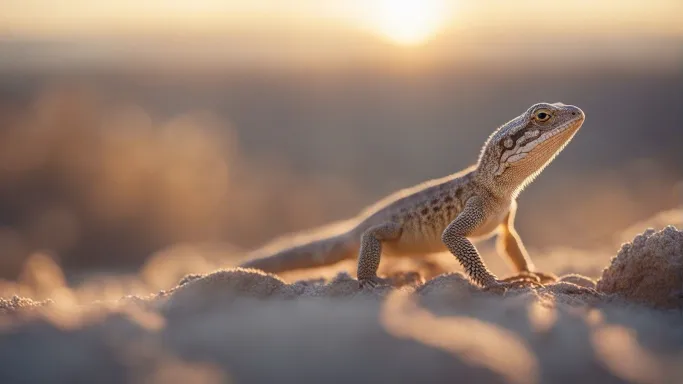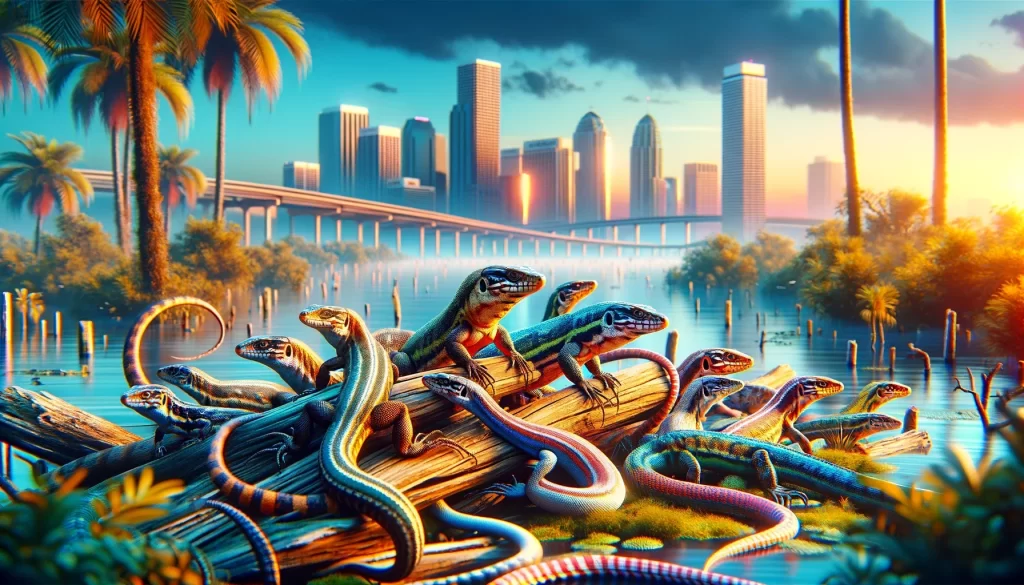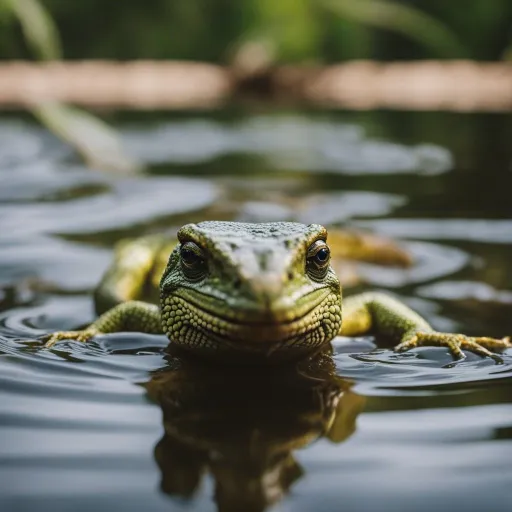So you’re curious about what baby lizards indulge in while scurrying around the sunny state of California?
Well, wonder no more! This article is here to satisfy your curiosity and shed light on the culinary preferences of these tiny reptilian creatures.
From their first hatching to their early stages of life, California’s baby lizards have a unique diet that fuels their growth and sets them on the path to becoming mighty adults.
Get ready to uncover the delicious secrets of what baby lizards in California truly feast on!
Factors Affecting Baby Lizard Diet
When it comes to the diet of baby lizards in California, several factors come into play. These factors determine the availability and variety of food sources for these young reptiles. Understanding these factors is crucial for ensuring the proper nourishment and survival of baby lizards.
Climate
The climate of California has a significant impact on the diet of baby lizards. The state’s diverse climate ranges from arid deserts to cooler coastal regions, creating distinct habitats for different lizard species. The availability of food sources for baby lizards in these habitats can vary greatly. The temperature and precipitation patterns in each region influence the abundance of insects, arthropods, and other prey items that serve as the main food sources for these reptiles.
Habitat
Another important factor affecting the diet of baby lizards is their habitat. Baby lizards can be found in a variety of habitats, including deserts, grasslands, scrublands, and forests. Each habitat provides different types of food sources for these young reptiles. For example, lizards in desert regions may have a diet primarily composed of insects and arthropods, while lizards in forested areas may have access to a wider variety of food sources, including small invertebrates and fruits.
Species
Different lizard species have distinct dietary preferences and requirements. Some species are insectivorous, meaning they primarily eat insects, while others may have a broader diet that includes small arthropods, invertebrates, and even plant matter. Understanding the specific needs of each species is crucial when determining the diet of baby lizards. Each species requires a specific balance of nutrients and may rely on certain food sources for their growth and development.
Age
The age of baby lizards also plays a role in determining their diet. Hatchlings have specific dietary requirements that differ from juveniles and adults. As they grow, their nutritional needs change, and their diet must adapt accordingly. It is important to consider the age of baby lizards when determining their diet to ensure they receive the necessary nutrients to thrive.
Availability of Food
Lastly, the availability of food is a significant factor influencing the diet of baby lizards. The abundance of food sources, such as insects, arthropods, and small invertebrates, in a particular area directly impacts what baby lizards can feed on. Changes in the availability of food due to factors like seasonal variations, climate fluctuations, or human activities can have a significant impact on the dietary options for baby lizards in California.
Common Food Sources for Baby Lizards
Baby lizards in California rely on a variety of food sources to meet their dietary needs. These food sources provide the necessary nutrients for their growth and development. Common food sources for baby lizards include insects, small arthropods, small invertebrates, and even certain flowers and fruits.
Insects
Insects play a crucial role in the diet of baby lizards. They provide a high protein content, which is essential for the reptiles’ growth and muscle development. Some common insects consumed by baby lizards include crickets, grasshoppers, beetles, ants, caterpillars, mealworms, and termites. These insects are abundant in various habitats across California and serve as a readily available food source for young lizards.
Small Arthropods
In addition to insects, baby lizards also feed on small arthropods. These include spiders, scorpions, centipedes, and millipedes. Although they may not be as abundant as insects, small arthropods still contribute to the dietary diversity of baby lizards, providing essential nutrients and offering a different taste and texture from their insect counterparts.
Small Invertebrates
Certain small invertebrates also make up part of the diet of baby lizards. Snails, slugs, earthworms, and grubs are among the invertebrates that baby lizards may consume. These invertebrates provide a different nutritional profile and add variety to the reptiles’ diet.
Flowers and Fruits
Some species of baby lizards in California may also consume certain flowers and fruits. Nectar and pollen from flowers, as well as soft fruits, can contribute to their diet. However, it is important to note that the consumption of plant matter varies among species, and not all baby lizards include flowers and fruits in their diet.

Insects as Primary Food
Among the various food sources for baby lizards, insects serve as the primary and most important source of nutrition. They provide essential proteins, vitamins, and minerals that are crucial for the healthy development of these young reptiles.
Crickets
Crickets are one of the most common and widely available insect food sources for baby lizards. They are rich in protein and relatively easy to find or breed for lizard owners. Crickets are a staple food for many lizard species, including baby lizards.
Grasshoppers
Another popular food source for baby lizards is grasshoppers. These insects are abundant in grasslands and provide a good source of protein. Baby lizards may particularly enjoy chasing and devouring these hopping insects, which also provide mental stimulation during feeding.
Beetles
Beetles are another insect group that baby lizards may feed on. They come in various sizes and shapes, providing a diverse food source. Some beetle species may have hard exoskeletons that offer additional benefits, such as promoting dental health and jaw muscle development for baby lizards.
Ants
Ants, both small and large species, are also part of the insect diet of baby lizards. They are a common food source due to their prevalence in many habitats. Baby lizards may hunt and consume ants, benefiting from the proteins and fats they provide.
Caterpillars
Caterpillars, the larval stage of moths and butterflies, are another nutritious food source for baby lizards. They are rich in proteins and fats, making them an ideal prey item. Baby lizards may enjoy the challenge of capturing and consuming these wiggly caterpillars.
Mealworms
Mealworms, the larvae of darkling beetles, are popular among lizard owners as a nutritious and easily manageable food source. They are rich in protein and fats, providing essential nutrients for baby lizards’ growth.
Termites
Termites, although often considered pests by humans, are a valuable food source for baby lizards. They provide a good source of protein and are abundant in many habitats, making them an easily accessible food option.
Small Arthropods
In addition to insects, baby lizards may also feed on small arthropods. These creatures are similar to insects but belong to broader arthropod groups such as spiders, scorpions, centipedes, and millipedes.
Spiders
Spiders, although feared by many humans, are a common food source for baby lizards. They provide a valuable source of protein and are abundant in various habitats. Lizards may hunt and feed on spiders, benefiting from their high nutritional content.
Scorpions
Scorpions, known for their venomous stingers, can also be a part of the diet of baby lizards. Their protein-rich bodies provide essential nutrients, and baby lizards may possess the ability to consume them without being affected by their venom.
Centipedes
Centipedes, with their many legs, are another small arthropod that baby lizards may feed on. These creatures offer a protein-rich diet option that contributes to the reptiles’ growth and development.
Millipedes
Similar to centipedes, millipedes are another small arthropod that baby lizards may consume. They present a different taste and texture compared to insects and other arthropods, adding dietary variety for these young reptiles.

Small Invertebrates
Baby lizards in California may also include small invertebrates in their diet. These creatures may differ from insects and arthropods in terms of their body structure and classification.
Snails
Snails, with their soft bodies and protective shells, are a potential food source for baby lizards. While they may not be as abundant as insects, snails can provide a different texture and nutritional profile for baby lizards’ diets.
Slugs
Slugs, similar to snails in terms of their soft bodies, can also be consumed by baby lizards. These slimy creatures offer a different taste and texture that baby lizards may find appealing.
Earthworms
Earthworms, often found in moist soil, can also be part of the diet of baby lizards. They are rich in protein and offer a different nutritional profile compared to insects and other small invertebrates.
Grubs
Grubs, the larvae of insects such as beetles, can act as a protein-rich food source for baby lizards. They are commonly found in soil and rotting wood, providing an additional dietary option for these young reptiles.
Flowers and Fruits
Although not a primary food source for all baby lizards, some species may consume certain flowers and fruits as part of their diet. These plant-based food sources can offer alternative nutrients and provide a more varied diet.
Nectar
Certain baby lizard species may consume nectar from flowers. Nectar provides carbohydrates and small amounts of other nutrients, serving as an additional energy source for these young reptiles.
Pollen
In addition to nectar, baby lizards may also consume pollen from flowers. Pollen contains proteins, fats, and other essential nutrients, contributing to the overall nutritional balance of their diet.
Soft Fruits
Soft fruits, such as berries, may also be part of the diet of some baby lizard species. These fruits provide a source of carbohydrates, vitamins, and minerals, adding dietary variety and nutritional benefits.

Diet Variations Among Different Species
The diet of baby lizards can vary significantly depending on the species. Different species have evolved to occupy various ecological niches, leading to specific dietary preferences and adaptations.
Western Fence Lizard (Sceloporus occidentalis)
The Western Fence Lizard primarily feeds on insects such as beetles, ants, and spiders. They are known for their ability to consume large numbers of beetles, making them an effective biological control for agricultural pests.
Alligator Lizard (Elgaria coerulea)
Alligator Lizards have a broader diet compared to some other lizard species. They feed on both insects and small vertebrates, including other lizards. Additionally, Alligator Lizards may consume various plant matter, making them omnivorous.
Side-blotched Lizard (Uta stansburiana)
Side-blotched Lizards primarily consume insects, including ants and beetles. They have a unique feeding strategy, with different individuals within a population specializing in specific types of prey.
Western Skink (Plestiodon skiltonianus)
The Western Skink has a diet primarily composed of small invertebrates, such as insects, spiders, and small snails. They may also consume pollen and flowers opportunistically.
Southern Alligator Lizard (Elgaria multicarinata)
Similar to the Alligator Lizard, the Southern Alligator Lizard has a diverse diet that includes insects, small vertebrates, and plant matter. They have been known to consume small birds and mammals, showcasing their adaptability as opportunistic hunters.
Specific Diets Based on Age
The dietary requirements of baby lizards can vary depending on their age. As they progress from hatchlings to juveniles and eventually become adults, their nutritional needs change, and their diet must adapt accordingly.
Hatchlings
Hatchlings have specific dietary requirements to support their rapid growth. They often rely on tiny insects and arthropods that are easily digestible, such as small ants, tiny beetles, and baby spiders. These small prey items provide the necessary nutrients for their early development.
Juveniles
As baby lizards grow into juveniles, their diet expands to include larger insects and arthropods. They may start consuming larger ants, beetles, grasshoppers, and even small lizards. Juveniles require increased protein intake to support their developing muscles, bones, and organs.
Adults
Once baby lizards reach adulthood, their dietary preferences may become more specialized, depending on their species. While insects and arthropods remain a primary food source for many species, some lizards may transition to a more herbivorous or omnivorous diet, incorporating plants, fruits, and even small vertebrates into their feeding habits.

Diet Adaptations to the California Climate
Baby lizards in California face unique challenges and adaptations related to the state’s climate. The ever-changing environmental conditions impact the availability and accessibility of food sources for these young reptiles.
Drought conditions
In drought-prone areas, the scarcity of water affects the availability of food for baby lizards. Insects and other prey items may become less abundant as their populations decline due to limited water resources. Baby lizards may need to adapt their feeding behaviors and search for alternative food sources during prolonged dry periods.
Heatwaves
California experiences frequent heatwaves, which can affect the behavior and activity of baby lizards. During extreme heat, insects and other prey may become less active, making it more challenging for baby lizards to find food. As a result, baby lizards may adjust their feeding patterns to opportunistically search for prey during cooler times of the day or in shaded areas.
Winter hibernation
In colder regions of California, baby lizards may undergo winter hibernation known as brumation. During this period, the availability of food drastically decreases. Baby lizards prepare for brumation by consuming larger quantities of food to build up fat reserves. They rely on these fat stores to sustain them throughout the winter when their metabolic rate decreases, and they remain relatively inactive.
Impact of Human Activities on Baby Lizard Diet
Human activities can have a significant impact on the diet of baby lizards in California. These activities often result in habitat loss, changes in food availability, and exposure to potential threats.
Habitat loss and fragmentation
The destruction of natural habitats due to urbanization, agriculture, and infrastructure development directly affects the availability of food sources for baby lizards. As their habitats shrink or become fragmented, baby lizards may struggle to find sufficient prey items, leading to malnutrition and population decline.
Pesticide use
The widespread use of pesticides in agriculture and urban settings can have detrimental effects on the food sources of baby lizards. Insecticides directly target the insects that baby lizards rely on for their diet, reducing their abundance and availability. Moreover, the consumption of insects contaminated with pesticides can negatively impact the health and survival of baby lizards.
Introduction of invasive species
The introduction of non-native species, such as plants, insects, and animals, can disrupt the natural food webs and impact the diets of baby lizards. Invasive species may outcompete native prey items or become toxic or unpalatable for baby lizards. The loss of native food sources and the introduction of new, unfamiliar prey options can create challenges for baby lizards in finding suitable and nutritious food.
Final Thoughts
In conclusion, the diet of baby lizards in California is influenced by various factors, including climate, habitat, species, age, and the availability of food.
Insects, small arthropods, small invertebrates, and occasionally flowers and fruits form the common food sources for these young reptiles.
The specific diet of baby lizards varies among different species and changes as they age.
However, human activities, such as habitat loss, pesticide use, and the introduction of invasive species, pose significant challenges and threats to the availability and diversity of food sources for baby lizards in California.
Understanding and addressing these factors are crucial for the conservation and well-being of these fascinating and important reptiles.




